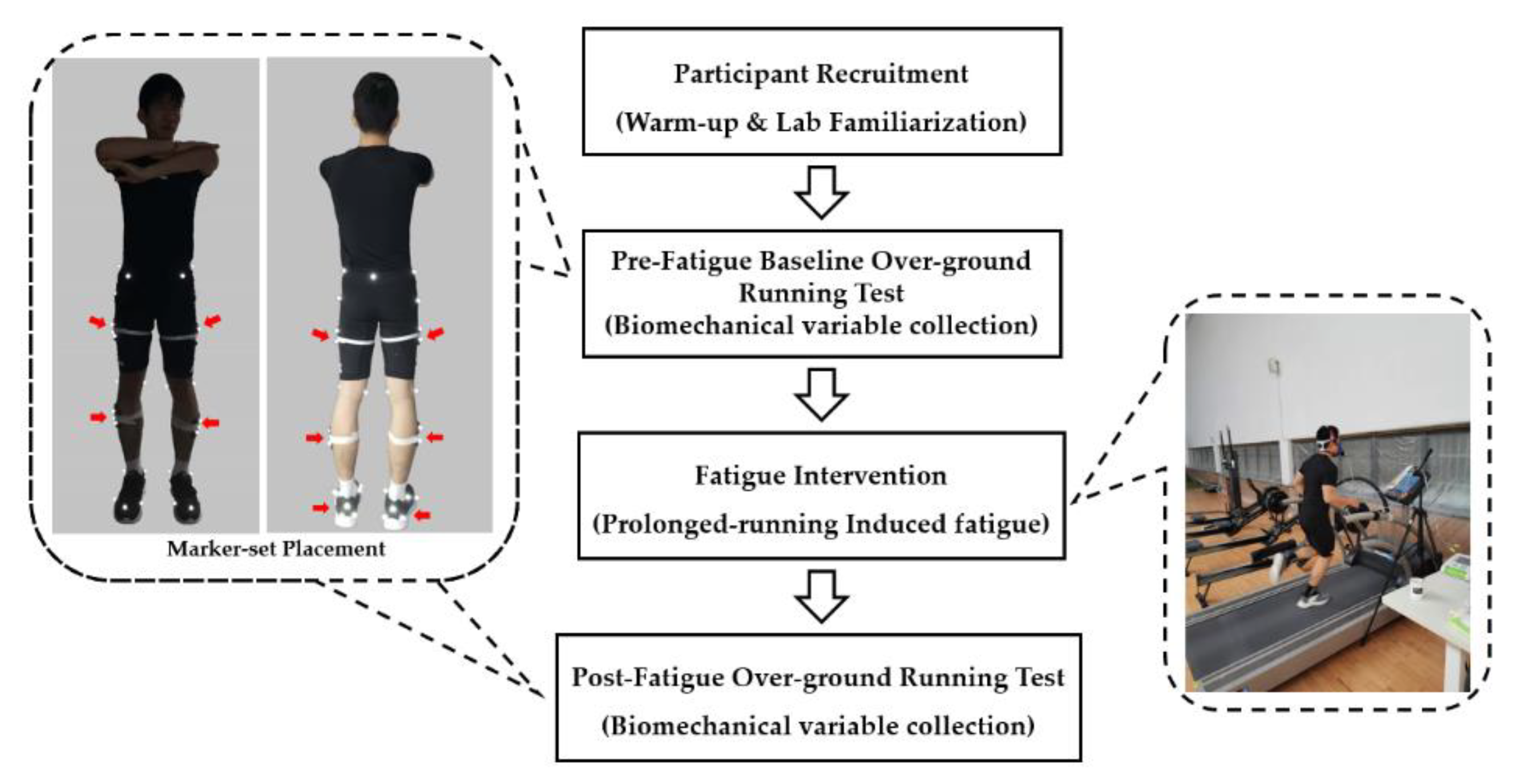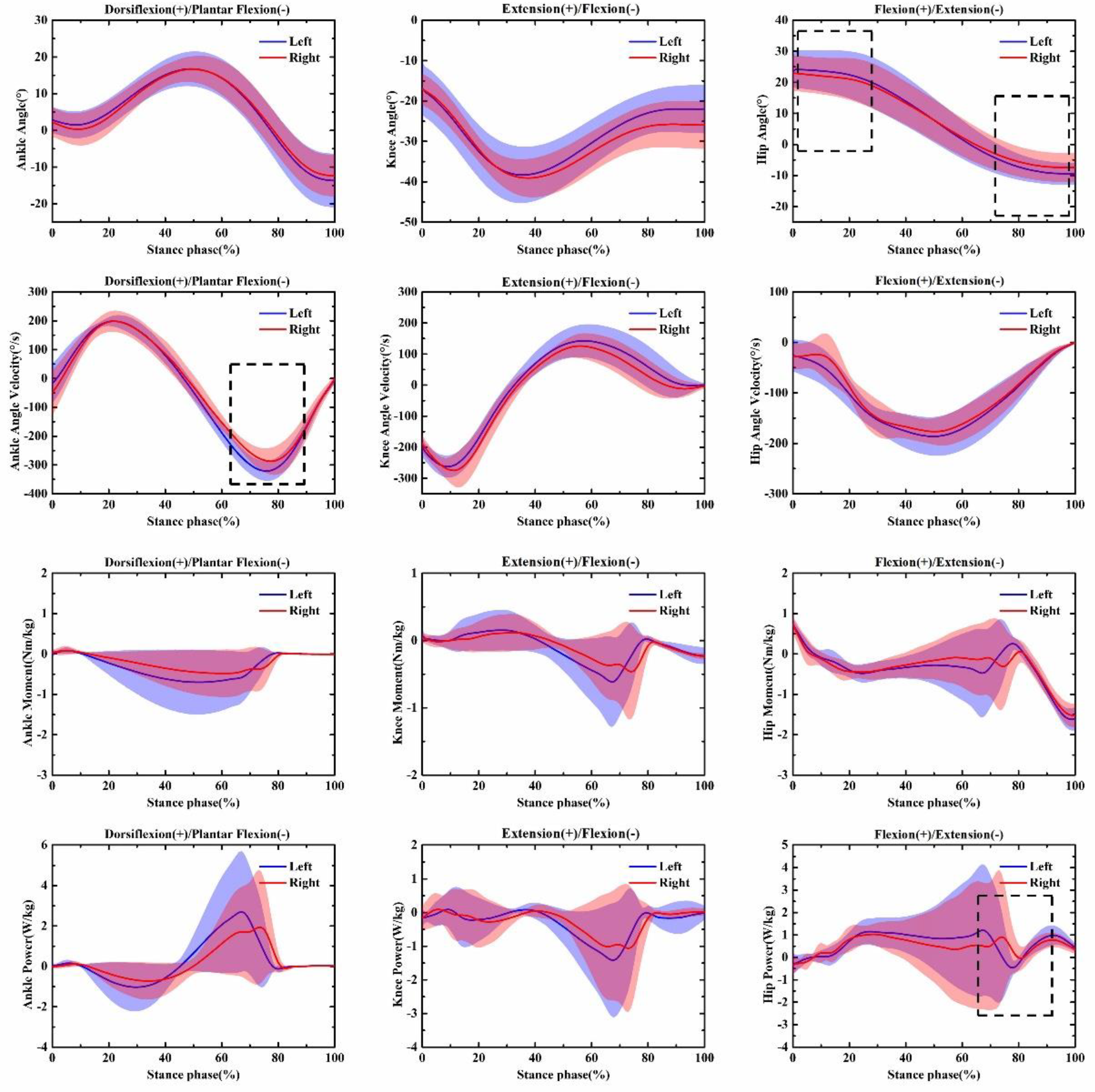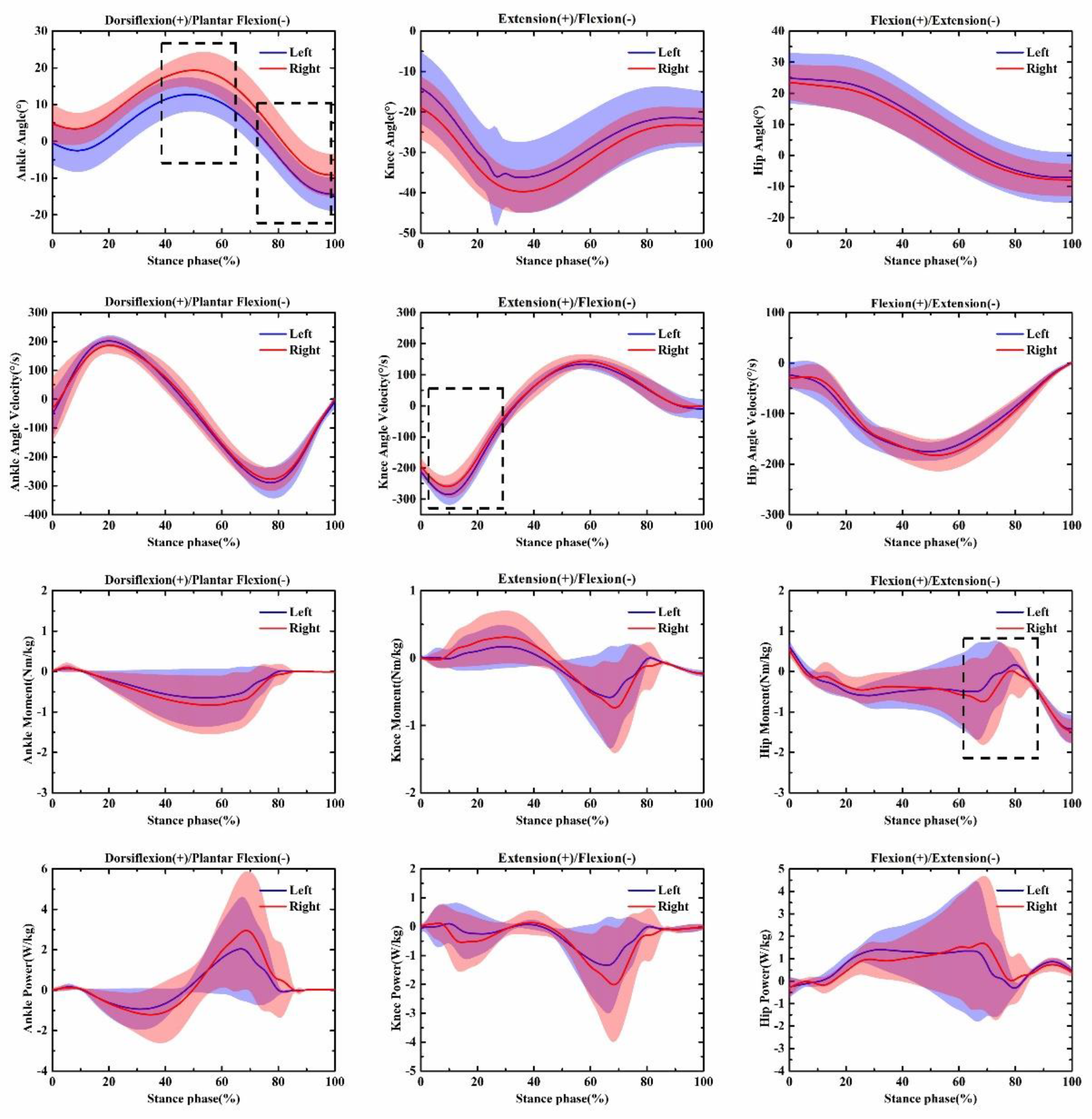The Effect of Prolonged Running on the Symmetry of Biomechanical Variables of the Lower Limb Joints
Abstract
1. Introduction
2. Materials and Methods
2.1. Subjects
2.2. Test Protocol
2.2.1. Biomechanical Variable Collection
2.2.2. Running-Induced Fatigue Protocol
2.3. Data Processing
2.4. Statistical Analysis
3. Results
4. Discussion
5. Conclusions
Author Contributions
Funding
Conflicts of Interest
References
- Polak, M.; Trivers, R. The science of symmetry in biology. Trends Ecol. Evol. 1994, 9, 122–124. [Google Scholar] [CrossRef]
- Kujanova, M.; Bigoni, L.; Velemínská, J.; Velemínský, P. Limb bones asymmetry and stress in medieval and recent populations of Central Europe. Int. J. Osteoarchaeol. 2008, 18, 476–491. [Google Scholar] [CrossRef]
- Polk, J.D.; Stumpf, R.M.; Rosengren, K. Limb dominance, foot orientation and functional asymmetry during walking gait. Gait Posture 2017, 52, 140–146. [Google Scholar] [CrossRef] [PubMed]
- Kim, C.M.; Eng, J.J. Symmetry in vertical ground reaction force is accompanied by symmetry in temporal but not distance variables of gait in persons with stroke. Gait Posture 2003, 18, 23–28. [Google Scholar] [CrossRef]
- Song, Y.; Zhang, W.; Zhao, L.; Sun, D.; Huang, Y.; Gu, Y. Sports-related injuries sustained by disabled athletes in Winter Paralympic Games: A systematic review. J. Med. Imaging Health Inform. 2020, 10, 1136–1143. [Google Scholar] [CrossRef]
- Schache, A.G.; Wrigley, T.V.; Baker, R.; Pandy, M.G. Biomechanical response to hamstring muscle strain injury. Gait Posture 2009, 29, 332–338. [Google Scholar] [CrossRef]
- Sadeghi, H. Local or global asymmetry in gait of people without impairments. Gait Posture 2003, 17, 197–204. [Google Scholar] [CrossRef]
- Radzak, K.N.; Putnam, A.M.; Tamura, K.; Hetzler, R.K.; Stickley, C.D. Asymmetry between lower limbs during rested and fatigued state running gait in healthy individuals. Gait Posture 2017, 51, 268–274. [Google Scholar] [CrossRef]
- Haugen, T.A.; Danielsen, J.; McGhie, D.; Sandbakk, Ø.; Ettema, G. Kinematic stride cycle asymmetry is not associated with sprint performance and injury prevalence in athletic sprinters. Scand. J. Med. Sci. Sports 2017, 28, 1001–1008. [Google Scholar] [CrossRef]
- Zifchock, R.A.; Davis, I.; Hamill, J. Kinetic asymmetry in female runners with and without retrospective tibial stress fractures. J. Biomech. 2006, 39, 2792–2797. [Google Scholar] [CrossRef]
- Furlong, L.-A.; Egginton, N.L. Kinetic asymmetry during running at preferred and non-preferred speeds. Med. Sci. Sports Exerc. 2018, 50, 1241–1248. [Google Scholar] [CrossRef] [PubMed]
- Laughlin, W.A.; Weinhandl, J.T.; Kernozek, T.W.; Cobb, S.C.; Keenan, K.; O’Connor, K.M. The effects of single-leg landing technique on ACL loading. J. Biomech. 2011, 44, 1845–1851. [Google Scholar] [CrossRef] [PubMed]
- Sadeghi, H.; Allard, P.; Prince, F.; Labelle, H. Symmetry and limb dominance in able-bodied gait: A review. Gait Posture 2000, 12, 34–45. [Google Scholar] [CrossRef]
- Levine, D.; Richards, J.; Whittle, M.W. Whittle’s Gait Analysis-E-Book; Elsevier Health Sciences: Amsterdam, The Netherlands, 2012. [Google Scholar]
- Brown, A.M.; Zifchock, R.A.; Hillstrom, H.J. The effects of limb dominance and fatigue on running biomechanics. Gait Posture 2014, 39, 915–919. [Google Scholar] [CrossRef]
- Niu, W.; Wang, Y.; He, Y.; Fan, Y.; Zhao, Q. Kinematics, kinetics, and electromyogram of ankle during drop landing: A comparison between dominant and non-dominant limb. Hum. Mov. Sci. 2011, 30, 614–623. [Google Scholar] [CrossRef]
- Schiltz, M.; Lehance, C.; Maquet, D.; Bury, T.; Crielaard, J.-M.; Croisier, J.-L. Explosive Strength Imbalances in Professional Basketball Players. J. Athl. Train. 2009, 44, 39–47. [Google Scholar] [CrossRef]
- Luo, Z.; Zhang, X.; Wang, J.; Yang, Y.; Xu, Y.; Fu, W. Changes in Ground Reaction Forces, Joint Mechanics, and Stiffness during Treadmill Running to Fatigue. Appl. Sci. 2019, 9, 5493. [Google Scholar] [CrossRef]
- Winter, S.C.; Gordon, S.; Watt, K. Effects of fatigue on kinematics and kinetics during overground running: A systematic review. J. Sports Med. Phys. Fit. 2016, 57, 887–899. [Google Scholar]
- Anbarian, M.; Esmaeili, H.; Esmaili, H. Effects of running-induced fatigue on plantar pressure distribution in novice runners with different foot types. Gait Posture 2016, 48, 52–56. [Google Scholar] [CrossRef]
- Farris, D.J.; Sawicki, G.S. The mechanics and energetics of human walking and running: A joint level perspective. J. R. Soc. Interface 2011, 9, 110–118. [Google Scholar] [CrossRef]
- Fourchet, F.; Kelly, L.A.; Horobeanu, C.; Loepelt, H.; Taiar, R.; Millet, G.P. High-Intensity Running and Plantar-Flexor Fatigability and Plantar-Pressure Distribution in Adolescent Runners. J. Athl. Train. 2015, 50, 117–125. [Google Scholar] [CrossRef]
- Hanley, B.; Tucker, C.B. Gait variability and symmetry remain consistent during high-intensity 10,000 m treadmill running. J. Biomech. 2018, 79, 129–134. [Google Scholar] [CrossRef] [PubMed]
- Wong, D.W.-C.; Lam, W.-K.; Lee, W.C.-C. Gait asymmetry and variability in older adults during long-distance walking: Implications for gait instability. Clin. Biomech. 2020, 72, 37–43. [Google Scholar] [CrossRef]
- Koblbauer, I.F.; Van Schooten, K.; Verhagen, E.; Van Dieën, J.H. Kinematic changes during running-induced fatigue and relations with core endurance in novice runners. J. Sci. Med. Sport 2014, 17, 419–424. [Google Scholar] [CrossRef] [PubMed]
- Hannigan, J.; Pollard, C.D. Differences in running biomechanics between a maximal, traditional, and minimal running shoe. J. Sci. Med. Sport 2019, 23, 15–19. [Google Scholar] [CrossRef]
- Mei, Q.; Gu, Y.; Xiang, L.; Baker, J.S.; Fernandez, J. Foot Pronation Contributes to Altered Lower Extremity Loading After Long Distance Running. Front. Physiol. 2019, 10, 573. [Google Scholar] [CrossRef] [PubMed]
- Borg, G. Borg’s Perceived Exertion and Pain Scales; Human Kinetics: New Milford, CT, USA, 1998. [Google Scholar]
- Fourchet, F.; Girard, O.; Kelly, L.A.; Horobeanu, C.; Millet, G.P. Changes in leg spring behaviour, plantar loading and foot mobility magnitude induced by an exhaustive treadmill run in adolescent middle-distance runners. J. Sci. Med. Sport 2015, 18, 199–203. [Google Scholar] [CrossRef]
- Bezodis, I.N.; Kerwin, D.G.; Salo, A.I.T. Lower-Limb Mechanics during the Support Phase of Maximum-Velocity Sprint Running. Med. Sci. Sports Exerc. 2008, 40, 707–715. [Google Scholar] [CrossRef]
- Winter, D.A. Biomechanics and Motor Control of Human Movement; Wiley: New York, NY, USA, 2009. [Google Scholar]
- Günther, M.; Blickhan, R. Joint stiffness of the ankle and the knee in running. J. Biomech. 2002, 35, 1459–1474. [Google Scholar] [CrossRef]
- Butler, R.J.; Crowell, H.P.; Davis, I.M. Lower extremity stiffness: Implications for performance and injury. Clin. Biomech. 2003, 18, 511–517. [Google Scholar] [CrossRef]
- Pease, W.; Bowyer, B.; Kadyan, V. Human walking, Physical Medicine and Rehabilitation, Principles and Practice, 4th ed.; Lippincott Williams and Wilkins: Philadelphia, PA, USA, 2005; pp. 155–168. [Google Scholar]
- Sadeghi, H.; Allard, P.; Duhaime, M. Functional gait asymmetry in able-bodied subjects. Hum. Mov. Sci. 1997, 16, 243–258. [Google Scholar] [CrossRef]
- Zifchock, R.A.; Davis, I.; Higginson, J.; Royer, T. The symmetry angle: A novel, robust method of quantifying asymmetry. Gait Posture 2008, 27, 622–627. [Google Scholar] [CrossRef] [PubMed]
- Exell, T.A.; Irwin, G.; Gittoes, M.J.; Kerwin, D.G. Implications of intra-limb variability on asymmetry analyses. J. Sports Sci. 2012, 30, 403–409. [Google Scholar] [CrossRef] [PubMed]
- Zifchock, R.A.; Davis, I.; Higginson, J.; McCaw, S.; Royer, T. Side-to-side differences in overuse running injury susceptibility: A retrospective study. Hum. Mov. Sci. 2008, 27, 888–902. [Google Scholar] [CrossRef]
- Gray, E.G.; Basmajian, J.V. Electromyography and cinematography of leg and foot (“normal” and flat) during walking. Anat. Rec. Adv. Integr. Anat. Evol. Boil. 1968, 161, 1–15. [Google Scholar] [CrossRef]
- Meardon, S.; Hamill, J.; Derrick, T.R. Running injury and stride time variability over a prolonged run. Gait Posture 2011, 33, 36–40. [Google Scholar] [CrossRef]
- Gandevia, S.C. Spinal and supraspinal factors in human muscle fatigue. Physiol. Rev. 2001, 81, 1725–1789. [Google Scholar] [CrossRef]
- Jiang, C. The Effect of Basketball Shoe Collar on Ankle Stability: A Systematic Review and Meta-Analysis. Phys. Act. Health 2020, 4, 11–18. [Google Scholar] [CrossRef]



| Joint Variables | Symmetry Angle (%) ± SD | ||
|---|---|---|---|
| Pre-Fatigue | Fatigue | p-Value | |
| Ankle | |||
| Dorsiflexion | 9.63 (6.98) | 13.67 (7.65) | 0.28 |
| Plantarflexion | 20.10 (12.53) | 21.66 (36.07) | 0.61 |
| Dorsiflexion velocity | 3.55 (3.36) | 3.61 (2.34) | 0.87 |
| Plantarflexion velocity | 5.19 (3.43) | 2.97 (3.32) | 0.11 |
| Dorsiflexion moment | 16.30 (14.54) | 22.45 (16.09) | 0.11 |
| Plantarflexion moment | 22.03 (20.49) | 28.69 (18.78) | 0.57 |
| Dorsiflexion power | 19.85 (16.73) | 26.98 (20.30) | 0.57 |
| Plantarflexion power | 18.67 (16.25) | 25.97 (19.59) | 0.50 |
| Stiffness | 18.66 (16.62) | 26.17 (19.59) | 0.31 |
| Joint Variables | Symmetry Angle (%) ± SD | ||
|---|---|---|---|
| Pre-Fatigue | Fatigue | p-Value | |
| Knee | |||
| Extension | 8.11 (7.36) | 22.25 (20.78) | 0.50 |
| Flexion | 4.66 (2.79) | 8.98 (4.23) | 0.02 * |
| Extension velocity | 8.94 (5.77) | 3.03 (1.70) | 0.02 * |
| Flexion velocity | 4.60 (4.58) | 4.39 (2.58) | 0.96 |
| Extension moment | 16.53 (13.18) | 29.17 (16.38) | 0.33 |
| Flexion moment | 14.87 (12.20) | 21.19 (15.37) | 0.19 |
| Extension power | 17.38 (9.50) | 16.48 (13.02) | 0.11 |
| Flexion power | 24.07 (13.88) | 25.47 (18.78) | 0.91 |
| Stiffness | 14.40 (12.71) | 22.06 (13.72) | 0.11 |
| Joint Variables | Symmetry Angle (%) ± SD | ||
|---|---|---|---|
| Pre-Fatigue | Fatigue | p-Value | |
| Hip | |||
| Flexion | 2.43 (1.71) | 13.14 (6.88) | 0.00 * |
| Extension | 18.12 (29.96) | 41.24 (34.76) | 0.02 * |
| Flexion velocity | 22.43 (16.47) | 16.98 (17.36) | 0.00 * |
| Extension velocity | 4.60 (4.58) | 4.39 (2.58) | 0.61 |
| Flexion moment | 3.01 (2.23) | 5.62 (3.37) | 0.02 * |
| Extension moment | 14.87 (12.20) | 21.19 (15.37) | 0.53 |
| Flexion power | 13.20 (12.91) | 22.11 (12.92) | 0.82 |
| Extension power | 13.12 (6.91) | 12.95 (8.85) | 0.91 |
| Stiffness | 6.04 (5.01) | 7.73 (8.46) | 0.53 |
© 2020 by the authors. Licensee MDPI, Basel, Switzerland. This article is an open access article distributed under the terms and conditions of the Creative Commons Attribution (CC BY) license (http://creativecommons.org/licenses/by/4.0/).
Share and Cite
Gao, Z.; Mei, Q.; Fekete, G.; Baker, J.S.; Gu, Y. The Effect of Prolonged Running on the Symmetry of Biomechanical Variables of the Lower Limb Joints. Symmetry 2020, 12, 720. https://doi.org/10.3390/sym12050720
Gao Z, Mei Q, Fekete G, Baker JS, Gu Y. The Effect of Prolonged Running on the Symmetry of Biomechanical Variables of the Lower Limb Joints. Symmetry. 2020; 12(5):720. https://doi.org/10.3390/sym12050720
Chicago/Turabian StyleGao, Zixiang, Qichang Mei, Gusztáv Fekete, Julien S Baker, and Yaodong Gu. 2020. "The Effect of Prolonged Running on the Symmetry of Biomechanical Variables of the Lower Limb Joints" Symmetry 12, no. 5: 720. https://doi.org/10.3390/sym12050720
APA StyleGao, Z., Mei, Q., Fekete, G., Baker, J. S., & Gu, Y. (2020). The Effect of Prolonged Running on the Symmetry of Biomechanical Variables of the Lower Limb Joints. Symmetry, 12(5), 720. https://doi.org/10.3390/sym12050720








